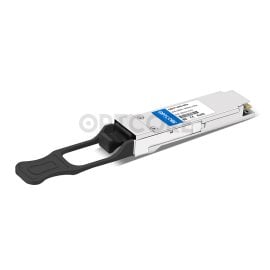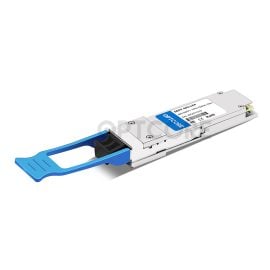Blog, Optical Transceiver
What is QSFP & QSFP+ Transceiver: An Ultimate Guide
In recent years, with the increasing demand for data centers and cloud computing, QSFP transceivers have become increasingly common in the high-speed connectivity industry. However, some new beginners are still unfamiliar with it, which is why we are creating this guide. In this comprehensive guide, we will explain what QSFP is, discuss its types, applications, and provide an in-depth overview of its features.
Now, let us get started.
Table of contents
What is a QSFP & QSFP+ Transceiver?
QSFP stands for Quad Small Form-factor Pluggable. By integrating four-lane signals into a single module, it supports four times the data throughput of the SFP while maintaining a slightly larger size.
Simply put, 1x QSFP Speed = 4x SFP Total Speed

The initial multi-source agreement, INF-8438i, was developed in 2006 by the SFF committee. In the initial MSA, QSFP supports 4x1G speeds, which are suitable for Gigabit Ethernet, Fiber Channel, and InfiniBand (SDR and DDR) applications.
However, around six years later, in 2012, the SFF committee developed a new agreement, called SFF-8436, to replace the original agreement.
Therefore, most people now refer to QSFP as QSFP+, or vice versa.
Strictly speaking, these two terms do not have the same meaning; QSFP+ strictly supports higher speed.
Yet, in practice, whether the guys mention those two words, they are likely to refer to the same term – QSFP+. Just because of this habitual way of saying it, in this article, we equate both terms.
QSFP Transceiver Types
Although there are many types available, we typically categorize them using various attributes.
By Media Type
- QSFP DAC: Direct attach copper cable with QSFP+ module on both ends, mainly for very short interconnectivity, like between adjacent switches or cabinets.
- QSFP AOC: Active optical cable with QSFP+ module on both ends, mainly for medium to long reach interconnectivity.
- Multimode QSFP: The MMF type utilizes the MPO fiber connector to support multi-fiber OM3, OM4, and OM5 cabling. A higher fiber grade provides better performance and a longer transmission distance.
- Single Mode QSFP: The SMF type typically features an LC connector and a WDM laser, suitable for 9/125 single-mode fiber cabling, offering a maximum link distance of 80 km at 40 Gbps.
By Protocols
- 40GBASE-CR4: unlike the common module, 40GBASE-CR4 is pre-terminated copper cable assembly with QSFP+ module on both ends, also called DAC cable. The transmission distance is limited to 7 meters (passive) or 10 meters (active).
- 40GBASE-SR4: SR4 stands for short reach four channels; it is based on 850nm technology and features an MPO connector, supporting 4x10Gbps speeds and a 100m distance over OM3 MMF.
- 40GBASE-ESR4: The “E” in the name means extended reach, which is the extended 40GBASE-SR4, providing a significantly longer transmission distance of 300m over OM3 or 400m over OM4 MMF.
- 40GBASE-LR4: LR4 stands for long reach four channels; it is based on CWDM technology and integrates four lasers into one LC interface, multiplexing them onto a single optical fiber. On the receiving side, the light is demultiplexed. LR4 usually supports a 10km distance via single-mode fiber.
- 40GBASE-ER4: Very similar to the 40GBASE-LR4, ER4 supports extended transmission distances of 30km or 40km via single mode fiber.
- 40GBASE-ZR4: ZR4 extends the supported distance further to 80km, primarily for typical telecom data transmission applications over long distances.
- 40GBASE-EZR4: EZR4 is not a standard protocol by the IEEE; however, many manufacturers use this term to refer to the ultra-long distance of 100km for QSFP+.
- 40GBASE-PSM4: PSM4 stands for Parallel Single Mode 4 lanes; it utilizes the MPO connector instead of the LC connector, based on parallel optics rather than CWDM4 technology, to lower manufacturing costs. 40GBASE-PSM4 utilizes a 4x 1310nm laser and receiver to support distances of 10km or 2km over 8-core or 12-core multi-fiber cables.
By Operating Temperature
This category is not as popular as the above lines; however, we can still categorize them as commercial and industrial type.
Commercial QSFP
The most common type, with a standard operating temperature of 0~70 °C, is typically used in indoor environments such as data centers, servers, and cloud computing clusters.
Generally speaking, because the operating environment is cleaner and more stable than some hardened applications, the requirements for equipment such as optical modules and switches are relatively lenient.
As a result, the total system costs less than the industrial application.
Industrial QSFP
It is specifically designed for harsh environments, such as those found in telecom, factories, and transportation infrastructure. It utilizes industrial ICs and optical assemblies, also passing the more stringent tests across a -40 to 85 °C temperature range to handle hardened industrial applications.
Due to the higher manufacturing cost and test process, it costs significantly more than the standard grade.
Recommended products
Frequently Asked Questions
Q: Who are the leading manufacturers of QSFP+ transceivers?
A: Many larger telecom equipment manufacturers and solution brands provide a wide range of QSFP+ transceivers, including Cisco, Juniper, HPE, Arista, and Dell. However, they usually source the module from top leading manufacturers, such as Coherent (formerly II-VI) and Innolight, and then rebrand it. OPTCORE holds various 40G modules in stock, is compatible with mainstream OEMs, and ships very fast worldwide. Contact our sales expert to determine your specific needs.
Q: What is the difference between QSFP+ and QSFP28?
A: You can hardly tell the difference only from the case appearance. The critical difference is the supported data speed. As its name suggests, QSFP28 supports 4x25G or 4x28G data rates, while the QSFP+ only supports 4x10G speeds. QSFP28 is the upgraded version of the 40G type, supporting a higher level of data streams.
Q: Can we connect a QSFP+ module to an SFP+ module?
A: It depends on the type of module. For the QSFP+ module with an MPO connector, you can connect it to four separate SFP+ modules via an MPO-LC breakout fiber cable. While the 40G module with an LC connector utilizes Wave Division Multiplexing, it cannot be directly connected to an SFP+ module.
Final Words
Despite AI computing dramatically driving the demand for higher-speed optics, such as the 400G OSFP and QSFP-DD, as well as the 800G OSFP and QSFP-DD, the earlier 40G QSFP still plays a significant role in enterprise networks and small to medium-sized business (SMB) data centers. I hope this comprehensive guide has helped you understand its history, types, and applications.
Reference
Read more
- 40G QSFP+ vs. 100G QSFP28 Transceiver: Pros and Cons
- What is QSFP & QSFP28 Port? Everything You Need to Know
- SFP+, SFP28, QSFP+, QSFP28, QSFP56, QSFP-DD, QSFP112 vs OSFP, What are the differences?










